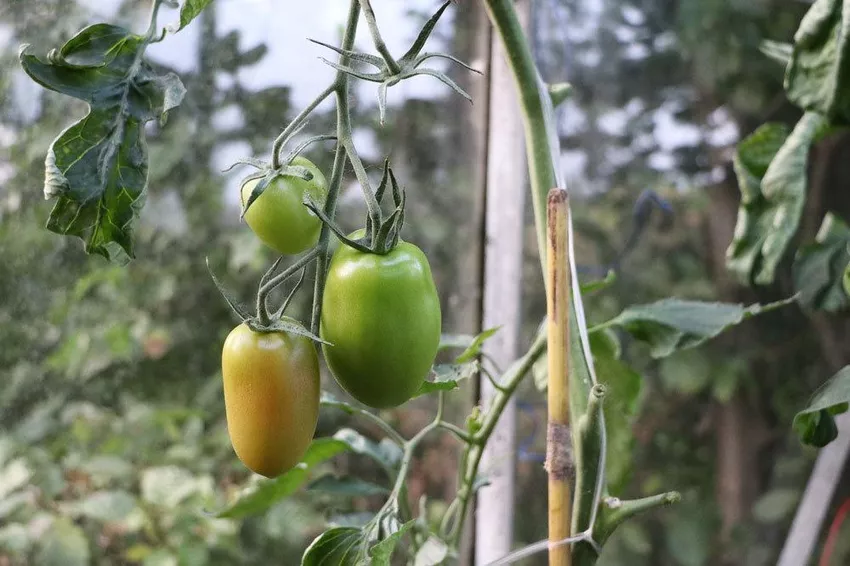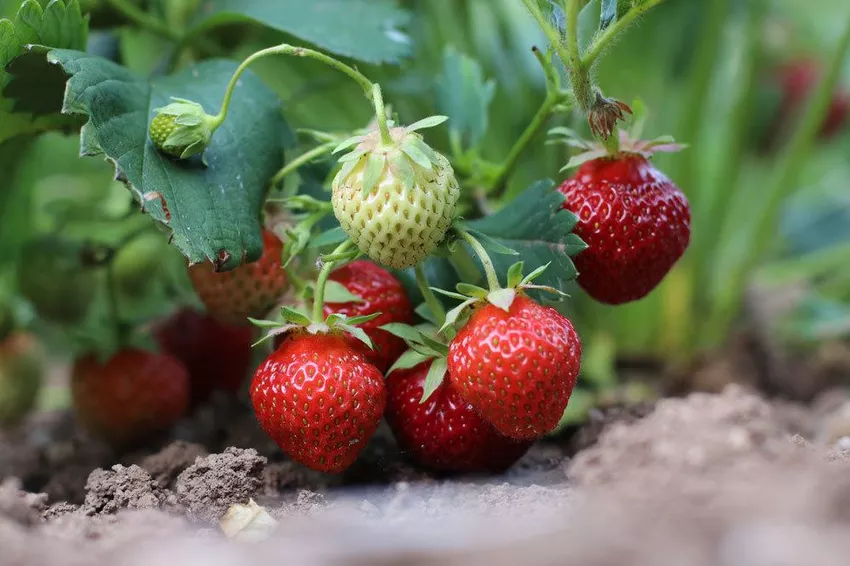
Whether in the raised bed, the vegetable garden or in the greenhouse, tomatoes are one of the classics. When planning the tomato bed correctly, the mixed culture is one of the most important aspects of successful cultivation. Which plants are compatible with the nightshade family and which are not is an essential point in order to obtain a bountiful harvest while optimizing the use of the soil. You will be amazed at the diversity presented here.
mixed culture
Why a mixed culture?
Mixed cultures are a variant of the classic vegetable patch that has been used for thousands of years to protect the soil and plants from nutrient deficiencies, pests and diseases. If different plant species from different families are placed with the tomatoes, they benefit from their properties. If suitable species are placed together in the bed, they function as a community, a biocenosis. They enrich the soil with their root exudates, the nutrient excretions of the plants, and at the same time mix their scents.

These mixed cultures enable the following positive effects:
- growth promotion
- Protection against diseases and pests
- Beneficial and pollinating insects are attracted
- a higher harvest is made possible
- the use of nutrients in the soil is optimized
- the aroma of the tomatoes becomes more intense
- due to the diversity of plants, it can withstand harsh weather
On the other hand, if species are placed next to the tomato plants that do not get along, there will be an imbalance in terms of nutrients. Since tomatoes are heavy feeders, they need a lot of nutrients and because they belong to the nightshade family, they are not designed for cultivation with other plants of this genus. They would only compete for location, which creates exactly the opposite effect. In the mixed culture with tomatoes, on the other hand, it is not so important whether other heavy consumers are planted, even if it is more advantageous to grow medium or weak consumers.
Good neighbors
Tomatoes are quite versatile vegetables and can be combined with a large number of different plants in intercropping. There are a few styles here for every taste.
Parsley (bot. Petroselinum crispum)
- parsley is a real dream for tomato enthusiasts, because the herb is ideal as a direct neighbor due to the essential oils and root exudates
Benefits:
- low nutrient requirement, as weak eaters
- protects against pests, especially various lice
Basil (bot. Ocimum basilicum)
- Basil is similarly effective as parsley, and both herbs get along exceptionally well with the nightshade family
- Of course, Ocimum basilicum is particularly good for Mediterranean vegetable beds, as the two plants fit together as one
 basil
basil
Highlight of the spice plant:
- Protection from greenhouse whitefly
- Protection against powdery mildew
Zucchini (bot. Cucurbita pepo)
- the zucchini is a pleasant neighbor for the tomato plants and ensures a harmonious soil condition, since both need sufficient mulch
This promotes:
- Development of effective microorganisms
- a strong growth
- better fruit formation
Just make sure the zucchini doesn't sink into the shade of the tomato, as it needs at least six hours of sun a day.
salads
- the numerous different types of lettuce are particularly suitable as a neighbor when there is not much space left
 lettuce
lettuce
If there is a lack of space in the bed, you should plant one of the following types of lettuce:
- Leaf lettuce (bot. Lactuca sativa var. crispa): Lollo Rosso and oak leaf lettuce
- Lamb's lettuce (bot. Valerianella)
- Arugula (bot. Diplotaxis tenuifolia)
Lettuce requires more space and should therefore not be sown if there is a lack of space, but otherwise gets along well with the tomato plants.
Celery (bot. Apium graveolens)
- Celery also goes very well with the tomato plants and creates an interesting effect
- the characteristic aroma of the celery is transferred to the tomato during the growth phase, which gives it a special kick and is a unique highlight in salads
Marigolds (bot. Calendula officinalis)
- Marigolds are ideal for the following two projects in mixed cultivation with tomatoes
- attract pollinating insects such as bees and bumblebees, enabling fruiting
- acts as a connecting plant for bad neighbors, especially peas
Asparagus (bot. Asparagus)
- If your tomato plants have ever suffered from the infamous tomato wilt (Fusarium wilt), consider growing asparagus next year
- Asparagus is effective against the fungus and frees the soil from it, which is good for the tomatoes
Marigolds (bot. Tagetes)
- Marigolds act as a precaution against diseases caused by viruses, fungi and bacteria such as nematodes
- The colorful flower also keeps pests such as whiteflies away
 tomato plants
tomato plants
cress
- For cress, it is advisable to plant nasturtium (bot. Tropaeolum) or garden cress (bot. Lepidium sativum) next to the tomato plants
- Due to the active ingredients contained, the cruciferous plants develop protection against aphids, which like to feast on the nightshade plant
The following crops can be grown without any problems, but have only a small effect on the tomato plants and are also positively influenced by it. They protect each other from diseases, which makes them extremely valuable.
- Spinach (bot. Spinacia oleracea)
- Radish (bot. Raphanus sativus var. sativus)
- Radish (bot. Raphanus sativus)
- Carrots (bot. Daucus)
- Leeks (bot. Allium ampeloprasum)
- Maize (bot. Zea mays)
- Garlic (bot. Allium sativum)
- Beans: the bush beans (bot. Phaseolus vulgaris var. nanus)
- Chicory (bot. Cichorium intybus var. foliosum)
- Kohlrabi (bot. Brassica oleracea var. gongylodes L.)
- Mint (bot. Mentha)
- Chicory (bot. Cichorium)
- Parsnips (bot. Pastinaca sativa)
These plants are great if you want to enjoy a wide variety and choice in your vegetable patch. Of course, optimal planning is part of this so that you do not combine bad neighbors who get along with the tomato plants but cannot stand together. An example here would be a trio of tomato, lettuce and parsley. The parsley acts far too strongly through the essential oils on the salads and damages them in an aggressive way. Therefore, you should always compare the other neighbors if you want to plant more than one species next to the tomatoes.

Tip: Never plant plant species together in the intercropping if they attract the same pests. A possible infestation by these same pests would spread rapidly within a short time, since the pests have more plant material available as a basis for nutrition.
Conditionally suitable neighbors
Peppers and strawberries are popular guests and are among the most commonly grown plants in German gardens. They are often discussed because they are neither good nor bad neighbors and make special demands on the gardener who wants to cultivate these two species together with tomato plants.
strawberries
- if you want to grow strawberry plants in the garden along with the tomatoes, you need to pay special attention to the species as follows
- Garden strawberry (bot. Fragaria ananassa): not suitable
- Wild strawberry (bot. Fragaria vesca): suitable
Due to the high water requirement of the tomatoes, the flavor of the garden strawberry is diluted and the tomato plant steals the light from it due to the height. It is better to rely on the wild strawberry, as it is used to little light and can even withstand moist soil. There are no positive effects recorded for strawberries and tomatoes.
 strawberries
strawberries
Paprika (bot. Capsicum)
- a mixed culture with peppers should be enjoyed with caution, because both plants need enough space
Yet:
- Peppers grow slower
- stay smaller
- benefit from the heat near the tomatoes
They thrive next to each other and should be fed adequately so they don't steal the nutrients they need. So give both types enough space.
Bad neighbors
The bad neighbors should be avoided in any case, as they will not have a positive effect on the mixed culture. If you have considered a combination of tomatoes and the bad neighbors, you should reconsider so that you are not disappointed with a sparse harvest in the end. A large part of the problems with these neighbors can be traced back to the different site conditions, because cucumbers, for example, need a completely different site than tomato plants. The bad neighbors are those listed below.
Potatoes (bot. Solanum tuberosum)
- both heavy feeders consume too many nutrients when placed next to each other
The consequences are:
- stunted growth
- poor fruit formation
- Tomato suffers from fungal disease: Phytophthora
- Phytophthora causes late blight and late blight
A culture with potatoes is only possible if you position the potatoes far enough away from the fruit vegetables. However, it is recommended that you give up growing potatoes altogether once you have tomato plants in mind.
 Potato plants in the garden
Potato plants in the garden
Cucumbers (bot. Cucumis sativus)
- both plants require completely different locations and therefore cause numerous problems when planted next to each other
- it is better to completely refrain from growing cucumbers because of the following points
- Tomato: possible attack of brown rot
- Cucumbers: possible infestation with spider mites and powdery mildew
- Stunted growth possible in both species
Peas (bot. Pisum sativum)
- due to the space requirements of both plants and the root exudates, peas do not get along next to tomato plants
- however, one way to combine the two is with the use of marigolds. Simply plant these between the pea and tomato plants 30 centimeters apart and you have a culture that works
- the flowers also attract numerous pollinators.
You should also avoid the following plants:
- Fennel (bot. Foeniculum vulgare)
- Beetroot (bot. Beta vulgaris subsp. vulgaris Conditiva Group)
- Red cabbage (bot. Brassica oleracea convar. capitata var. rubra L.)